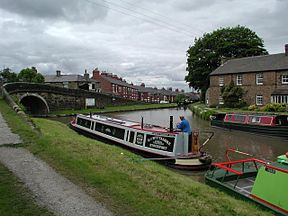Marple Junction
| Marple Junction | |
|---|---|

Junction of Peak Forest Canal in Marple
|
|
| Specifications | |
| Status | Open |
| Navigation authority | British Waterways |
| History | |
| Date completed | 1831 |
| Date closed | 1939 |
| Date restored | 1974 |
Marple Junction (grid reference SJ961884) is the name of the canal junction where the Macclesfield Canal terminates and meets the Peak Forest Canal at Marple, Greater Manchester, England.
The water of the two canal companies was kept apart by a stop lock in the narrows at the end of the later Macclesfield Canal, but this has long since been de-gated, and the two canals run at the same level.
The Peak Forest Canal was authorised by an Act of Parliament obtained in 1794, which was designed to access the limestone deposits at Doveholes, near Whaley Bridge. The canal ran from Dukinfield Junction on the Ashton Canal to Bugsworth Basin, from where a tramway ran the final 6.5 miles (10.5 km) to the quarries, which were over 1,000 feet (300 m) above sea level. There were two level pounds on the canal, separated by a flight of 16 locks, which raised the level by 214 feet (65 m). Most of the canal opened in 1800, but the locks were not completed until 1804, and a second tramway was used to bypass the locks until they were ready.
Although a route through Macclesfield to connect the Trent and Mersey Canal to Manchester had been suggested as early as 1777, an Act of Parliament was not obtained until 1826, following a survey by Thomas Telford. The canal opened on 9 November 1831, and like the Peak Forest, was built as two level sections, with a flight of locks between them, in this case the twelve Bosley locks, which raise the level by 118 feet (36 m). The junction with the Peak Forest Canal is just above the top lock of the Marple flight.
...
Wikipedia
